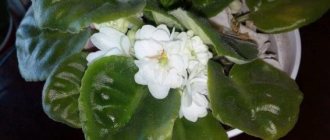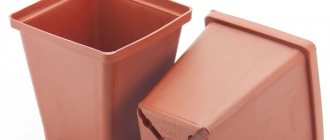One of the most favorite indoor plants can be called the violet. These unusually beautiful flowers are liked by gardeners because of their ease of care, long-lasting flowering, and the magic of colors. The collection of Tatyana Lvovna Dadoyan is especially popular. Experienced flower growers advise paying attention to the Water violet - a brightly colored variety with a cool ruffle. We bring to your attention a description of the variety, features of care and reproduction.
Violet Water: description
The Water violet variety has large double flowers of a bright blue rich color, with stripes or small areas of light pink along the edges of the petals, edged with a green fringe. The leaf is delicate, velvety, convex, green in color with a wavy edge. The bottom of the leaf is white, sometimes there may be red spots on it, the stems are light. The elegant fringe on large flowers distinguishes the Vodyanaya violet variety (Dadoyan has already developed several popular varieties). Saintpaulia really looks like underwater plants.
The children of this violet variety are curly, and the leaves can be light. Can be grown in a collection with other flowers that are similar in care and color scheme. For the Water violet, it is necessary to observe the thermal and light conditions, and do not forget about timely watering.
Peculiarities
Such a culture is in demand from the very beginning. The reason is simple: flowers with a pleasant purple color are liked by almost everyone. “Water” has purple paint diluted with white, pink and green notes. Thanks to them, plants turn out to be more romantic and even a little more mysterious. The variety was developed by the famous breeder T. Dadoyan.
During the development process, in addition to the non-standard colors, we managed to make the petals as convoluted as possible, and the leaves are the same. Therefore, the flower has become more elegant than many other varieties. Flowers of “Vodyanoy” belong to the double group. They reach a large size. The perimeter of the petals is decorated with a powerful fringe.
The petals are painted a deep blue or even purple. Pale pink inclusions are added to them in random order. The petals at the tips also have a pinkish color. At the very edge there is a greenish ruffle that bends into a spiral. The appearance of the flower changes when the buds bloom - that’s why neither photos, nor videos, nor verbal stories can reflect all the charm of the “Vodyany”.
Water violet blooming: photo
Violet bloom lasts about a month, a little longer in a cool room. For violets of this variety, the opening of the buds takes a long period of time. One peduncle usually has up to five buds in a bouquet. The diameter of the bud opens up to six centimeters. The Vodyanoy violet begins to bloom fully from the 3rd time, and the duration of flowering directly depends on the lighting.
Choosing soil and pot
Water violet should be replanted twice a year, it is better to do this in spring and autumn. There are few basic requirements for the soil - it is fairly loose, fertile soil with good moisture holding capacity. You can make this soil yourself, or you can purchase a ready-made soil mixture in the store.
It is necessary to choose the right size of the pot: its diameter should be slightly larger than the root system of the violet. In addition, it is better to choose a low and wide flowerpot. The material from which it is made should also be taken into account. If the pot is ceramic, then the moisture in it evaporates much faster than, for example, in a plastic one.
Reproduction and transplantation
Water violet reproduces by rooting leaves, peduncles or stepsons. Stepchildren form a rosette in abundance, from three to five pieces. During the annual transplantation of violets, they are separated from the mother rosette using an awl and planted in separate pots.
The plant can also be propagated by rooting a leaf or peduncle. A leaf for rooting is taken from an adult plant directly under the peduncle. Leaves from the center of the rosette and from the bottom row are not suitable for propagation.
Water violet is best propagated by separating flower stalks.
The leaf is carefully broken off, and then a cut is made at an angle of 45 degrees and placed in a glass of water or a mixture of sand and soil. The cuttings are buried no more than 1 centimeter. During spring rooting, babies appear on the cuttings after 2 months.
The peduncle for rooting is cut off along with the stipules and placed in a glass of water. Peduncles with flowers that have blossomed or have begun to fade are suitable for rooting. The procedure is carried out with a sharp, disinfected knife. The cut area is sprinkled with crushed charcoal.
Transfer rules
Indoor violets are replanted annually, in the spring, since during the growing season the soil in the pot is depleted and there is not enough fertilizer to nourish the plant. The soil for the plant must be selected as loose and light as possible. You can use ready-made soil for violets from the store or make a mixture yourself from leaf and turf soil, peat, sand and vermiculite.
The pot for replanting is taken 1-2 centimeters larger than the root system of the plant. The pot should gradually increase in size as the violet grows and matures. As soon as the size of the pot reaches 10 centimeters in diameter, its increase is stopped. You cannot plant violets in pots that are too large. Until the roots fill all the spaces of the dishes, the violet will not bloom.
Care
Growing beautiful, lush violets at home is quite simple, the main thing is to strictly follow the recommendations for caring for these plants. And then it will respond with lush and long flowering.
In order to get abundant flowering of violets, you need to provide the plants with proper care. If Saintpaulias do not begin to bloom, the following reasons are possible:
- plants do not have enough lighting;
- short daylight hours;
- lack of microelements;
- dry air.
All this can be easily corrected: use artificial lighting, feed the plants, and carry out regular spraying.
Plant care
Watering occupies a special place in violet care. Excessive soil moisture, as well as overdrying, is not acceptable. The plant needs to be watered 2-3 times a week, depending on the air temperature. For irrigation, use warm water that has been standing for at least a day.
Attention. Watering with cold water will shock the root system and cause it to rot.
To water violets, use a watering can with a long spout or a syringe bulb. Water should not get on the leaves of the plant or in the center of the rosette. If water accidentally gets on the leaves while watering, you should immediately blot them with a napkin.
It is important to properly water the Water violet variety.
You can water the violet through a tray, placing the flower pot in it at a height of 2/3. After 30 minutes, the violet will absorb the required amount of liquid and the pot can be removed from the pan. Bottom watering will help prevent the violet from becoming waterlogged.
Experienced flower growers advise using wick watering for watering violets. To organize the pot with violet, place a cord with a diameter of 0.3 to 0.5 centimeters. The end of the cord is released through the drainage hole and placed in a vessel with water located under the pot of violets.
The plant absorbs the required amount of moisture through the cord.
Organization of fertilizing of Vodyanaya violet
Normal growth and abundant flowering of violets is possible only if it is provided with all the necessary nutrients. The plant needs nitrogen, phosphorus and potassium in sufficient quantities. Too much nutrition is just as harmful as too little.
For optimal plant nutrition, the following fertilizers must be used:
- Minerals are superphosphates, which ensure active growth and flowering.
- Complex mineral mixtures.
- Organic fertilizers - humus or humus.
Organic fertilizers are used for fertilizing during the formation of a leaf rosette. Phosphorus-potassium - during the formation of buds and flowering. Fertilizers are applied once every 2-3 weeks at the root.
Fertilizing violets is not recommended in the following cases:
- After transplantation within 30 days;
- In case of weakening of the plant by diseases and pests;
- In hot weather and in winter.
Important. It is not recommended to use fertilizers in tablets and granules for fertilizing violets. These fertilizers are intended for large plants. When using them for violets growing in small pots, you can violate the dosage and harm the plants.
Water violet is fed with mineral and organic fertilizers.
Water violet hygiene and rosette formation
Violet leaves need to be regularly cleaned of dust that settles on the fibers. To do this, the plant is bathed in the shower once a month. The violet is placed in a bath and washed with a weak string of warm water. After bathing, the plant should not be immediately exposed to the window so that droplets of water do not cause burns.
The Water Violet forms a beautiful rosette on its own, but it needs help by turning the pot 45 degrees every 3-4 days. The rosette must be regularly cleared of old leaves and drying flower stalks.
[adsp-pro-6]
Once every 4-5 years, the violet rosette is rejuvenated. All the leaves of the lower row are removed from the plant, then the top is cut off and rooted in water. After the roots have formed, the rosette is planted in a pot with soil.
Lighting
Violets (Saintpaulias) require a large amount of light, preferably diffused. Direct sunlight is extremely undesirable for them, as it can cause leaf burn in plants. If the violet is on the windowsill on the south side, the plants need to be shaded. And in order for the violet to bloom all year round, artificial lighting is also suitable: it should be approximately 12 hours a day.
Temperature and humidity
For Saintpaulias, the most ideal temperature is considered to be from 20 to 24 degrees Celsius. For young plants, the room in which they are located can be made a little warmer. There should be no difference between day and night temperatures.
Water violet is especially demanding of humidity due to the fact that in its natural environment it lives in a fairly humid climate. To create comfortable conditions for the violet, it is necessary to maintain a high level of humidity in the room or periodically spray the air around the plants.
Care and other nuances
Proper watering of violets is of great importance. You will have to carefully maintain the humidity balance. Water plants need to be irrigated twice or thrice a week. Air temperature gives a more accurate estimate. Important: you should pour only warm water that has been pre-settled for at least 24 hours.
If you pour cold water on a violet, the root complex will experience a real shock. After this, the roots may even begin to rot. It is also important how the plant is watered. For this purpose, watering cans with elongated spouts are used. As an option, they take douche bulbs.
It is strictly forbidden to allow the foliage to get wet. Moistening the middle of the outlet will also be very bad.
Accidentally wet leaves are immediately dried with a completely dry cloth.
To ensure that negative phenomena are prevented, you can use alternative irrigation methods. Watering through a tray means placing the pot in it two-thirds full. When 30 minutes have passed, you can remove the pot. Usually this time is enough for the root system to receive the required volume of liquid. Bottom watering is good precisely because it helps to avoid excessive moisture of the soil. If you have experience, you can also try wick irrigation, in which a cord with an external cross-section of 0.3-0.5 cm is placed inside the pot.
One of the ends of the cord is located inside, in the layer of earth. The other edge is taken out through the drainage channel and lowered into a container of water. It should be located exactly below the pot. But, in addition to liquid, it is necessary to supply the violet with nutrients. A special place among them is occupied by:
Attention: the amount of fertilizer applied must be determined very carefully. Their excess can have an extremely negative effect on flowers. Rational nutrition includes the use of:
- combined compositions of mineral substances;
- superphosphates;
- humus or humus.
Organic matter should be supplied when the leaf rosette folds. The turn of phosphorus and potassium comes when buds are formed, and then flowers develop from them. Any fertilizers are applied once every 14-21 days at the root. But this graph cannot be considered an absolute dogma. Breaks in the addition of fertilizers may be due to the following reasons:
- plant transplantation (in the first 30 days, regardless of the progress of rooting);
- disease detection;
- pest damage;
- excessively high room temperature.
Fertilizing violets is also stopped for the winter. At this time, the plant should function as calmly as possible; there is no need to stimulate its activity. In any case, you cannot feed “Waters” with tablets and granules. Fertilizers in such forms are needed primarily for large growth. In a small pot it is too easy to overdosage and cause damage to the flower.
Protection from diseases and pests
Like all plants, violets suffer from diseases and pests. The most common pests include mealybugs and spider mites. In order to get rid of a tick, you need to use insectoacaricidal drugs. For example, such as "Aktellik" or "Fitoverm". When fighting mealyworms, you can use any of the insecticidal preparations. But still, at home it is better to use the Aktara product; the drug is quite effective, fast-acting, and odorless. Usually a single treatment is sufficient.
Most of all, violets are susceptible to rot of various origins. To avoid this, you should be careful about watering and avoid excessive waterlogging of the soil.











